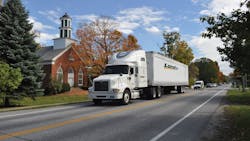It’s a headline professional drivers never want to experience firsthand: “Truck wedged under bridge after driver takes wrong path.” That wrong path is typically taken after a consumer navigation system directs commercial trucks down a road or parkway that can’t handle the size and weight of that vehicle.
These headlines are avoidable. Motor carriers today can turn to industry-specific technology to help them optimize their routes and dispatch operations, provide better visibility to drivers both along their route and when entering and exiting customer facilities, and manage the complexities of toll costs.
Today’s market offers an abundance of commercial vehicle navigation systems, so incorporating devices tailored to fleet vehicles and operations is key.
“If you’re running a flatbed or refrigerated truck, you might have different parameters,” explained Rishi Mehra, director of operations and strategy for Trimble MAPS, which offers commercial routing, scheduling, and navigation solutions. “If you’re running navigation for driving through higher altitudes or if you are hauling chips or certain bagged grocery items, you wouldn’t want to go through higher elevations because the bags would pop open. Those are all things that you need to factor in.”
Because trucks, loads, and routes are so different depending on the freight lane a carrier is covering, Andrew Johnson, chief marketing officer for PrePass Safety Alliance, noted the importance of standardizing navigational tools for drivers and the back office.
“It’s important to standardize on one navigation platform so that you know all the trucks are using a reliable navigator, as well as having documented policies in place that reinforce safety,” Johnson said. “If a driver gets into a crash that is a result of poor navigation, you can show that you took the proper steps to develop safe routing practices.”
See also: How technology can impact a fleet's insurance policy
Standardizing dispatch and routing can better help carriers work out their lanes to maximize efficiency and avoid potential challenges, such as tolls, traffic, geography, and terrain. Many fleets today also are looking to augment driver capacity and better utilize the assets that they already have in a tight market.
An evolving system
One carrier has found a system to help solve some of today's capacity challenges. Southwestern Motor Transport (SMT) is a Texas-based truckload and less-than-truckload (LTL) carrier that runs many routes in the LTL pickup-and-delivery (P&D) space. The third-generation, family-owned company has been in business since the 1930s and constantly is open to new ways to optimize its P&D routes, noted Robert Bernal, SMT’s VP of information technology.
SMT ended up turning to HaulSuite, a provider of LTL optimization solutions, and recently completed the rollout of HaulSuite’s full RouteMax P&D solution across SMT’s 16 terminals and some 250 drivers.“The business is always evolving, and we are always trying to cater to the customer, so things change, times change, weight changes, appointments change,” Bernal told FleetOwner. “The system gives us the ability to factor in adjustments, optimizing them on the fly, and then we are able to make changes and modifications.”
RouteMax has helped SMT with inbound planning and dispatch, giving the fleet real-time information to improve driver productivity and truck utilization. According to Bernal, one of the biggest efficiency gains using RouteMax is getting customer bills entered much faster.
“We are getting that bill of lading scan at the customer door with the driver and immediately feeding that into our system,” Bernal said. “If we can get 80% of those bills automatically entered, I am good with that.”
See also: Transforming the art of dispatching
Utilizing technology for route planning capabilities has also helped SMT step back and look at the bigger picture.
“We have some smart people that used to [manually] optimize the routes, but the problem is when those people are sick or when people go on vacation, you notice that drop in human optimization,” Bernal explained. “Now, we have that experience and talent 24/7. By no means is it going to replace the people that we have, but it has helped us gain a lot of efficiencies.”
Aside from gains made in the back office, another key objective of HaulSuite’s RouteMax technology is to reduce the number of drivers needed on any given day, noted Rambabu Yadlapalli, lead product manager for HaulSuite.“We are trying to see how effectively we can create routes, how effectively we can make them operational with fewer drivers by reducing driver needs and at the same time making sure we are not missing any customer appointments,” Yadlapalli said. “Human brains obviously are the best. But with these optimization techniques, we make sure that some of the things that might have been overlooked by the manual planning, we are giving visibility back to the planners.”
Mapping, automated routing
When it comes to giving visibility back to a fleet’s planners, Carrier Logistics Inc. (CLI) provides automated routing and mapping technology for asset-based LTL carriers and has worked to take much of the manual decision-making out of the equation. CLI has focused on automating routing using an optimization model that prioritizes least miles and keeping drivers in geographies that they are familiar with. According to President Ben Wiesen, CLI’s FACTSmap app works like a digital dispatcher.
FACTSmap shows where any truck is in real-time, as well as outstanding deliveries and unassigned pickups.
“We’ve found that in the industrial LTL market especially, repeat stops you have one day you are likely to have the next day,” Wiesen explained. “Keeping the driver assigned to a geography sometimes leads to an improvement because the driver becomes accustomed to that customer. They know the shortcuts, the procedures, and the ins and outs of that location.”
Working with human dispatchers, CLI’s application highlights certain items that need a dispatcher’s attention. Because, according to Wiesen, today’s dispatchers are responsible for way too much.
“They might have a fleet of 50 trucks that they are managing or dispatching, but one of those trucks might have 25 stops assigned to them in an LTL environment,” Wiesen explained. “The dispatcher is responsible for a significant number of tasks, and it’s impossible for one person to remember that many things all the time.”
CLI customer LandAir, a privately held asset-based carrier operating in the Northeastern part of the U.S., has a series of service centers that handle last-mile pickup of shipments. LandAir also has a linehaul network that moves freight between terminals.The carrier is managing high velocity without much downtime. LandAir’s main goal is getting back to the terminal in time to meet an aggressive linehaul schedule and arrive at a destination in a short window of time—with one load of freight likely transferring onto three different trailers.
LandAir uses CLI’s suite of technology to help route each pickup to the service center and optimize the vehicles picked up.
“They’ve found the ratio of stops per dispatcher, drivers per dispatcher, and service centers per dispatcher has improved, and the dispatcher can handle more responsibility because the technology automates many of the completely clerical parts of dispatching,” Wiesen said. “It allows dispatchers to focus on challenges, like when a truck gets stuck at a customer location or gets stuck in traffic.”
A lot of emphasis has been placed on optimizing delivery operations in the LTL segment because if shipments aren’t loaded onto a trailer in time, it puts stress on all shipments for the routes that follow, Wiesen added.
Stay tuned for part two, which focuses on how optimizing routes can impact truck driver satisfaction.
Overcoming toll management complexities
According to Tom Fogarty, CEO of fleet toll management provider Bestpass, there isn’t too much that can get more complex than managing tolls. A solid toll management plan also can help improve driver satisfaction.
Having a toll management plan in place, typically via one portal or interface, can help carriers view all their billing and multiple reporting options, Fogarty stressed. A toll management plan also can significantly reduce costs and transponder violations, as there are multiple tolling agencies throughout the country, and fleets registered for tolling in one state might have a problem with billing from another.
If fleets don’t have the right transponder technology in place, for example, trucks running from coast to coast could end up being a series of violations waiting to happen.
In a recently released whitepaper, a third-party company interviewed Bestpass customers, who estimated they saved north of 10% on tolling since implementing the toll management platform.
“They seem to understand where is that optimal route management, and they are not rebilling customers because they didn’t realize the toll cost had changed,” Fogarty said.
He added that if a gantry doesn’t pick up a vehicle’s transponder for whatever reason and a carrier gets billed for the maximum rate for that toll road or bridge, Bestpass can review the data through track records and auditable travel patterns to prove to the tolling authorities that the bill was too high.
Through its mobile app, Transflo provides some insights into the tolls on the lanes that fleets are running and what they should expect to pay. Based on their dollar-cost-per-minute of delay, fleets can also decide ahead of time if it’s worth having a driver take a toll road or not.
“I have seen fleets that have tried to avoid tolls altogether; it is definitely a detriment to certain drivers when they see the wasted time by not taking the toll road,” Doug Schrier, SVP of strategy at Transflo, pointed out. “And drivers don’t get paid when there is congestion. So, when there is not a toll road and they are moving at an average speed of 25 mph, whereas if they were on a toll road and they could be at 50 mph, their pay is reduced."
“That is definitely something a fleet has to take into consideration,” Schrier continued. “What’s optimal for our bottom line, and then what are the drivers going to view if I set this optimally for my bottom line? You have to take that driver’s experience into account when you do that.”
Cost management is really where the toll data comes into play, noted Andrew Johnson, chief marketing officer for PrePass Safety Alliance. PrePass offers a toll payment service in which fleets could access a toll analytics software tool, which provides them information about tolls they are incurring and also the ability to identify incorrect charges and then dispute the incorrect charges with each agency.
Tools like this can help fleets import toll data directly into their routing and TMS system. “With the information from their routing system and the information from their toll data, they are able to develop the reports to more accurately determine the cost of specific lanes based on the actual toll cost they are incurring,” Johnson explained.
About the Author

Cristina Commendatore
Cristina Commendatore is a past FleetOwner editor-in-chief. She wrote for the publication from 2015 to 2023.



